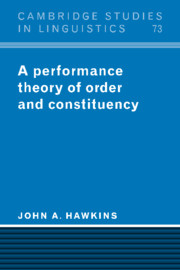Book contents
- Frontmatter
- Contents
- Preface
- Acknowledgments
- List of abbreviations
- 1 Introduction
- 2 The grammaticalization of processing principles
- 3 Early immediate constituents
- 4 Testing EIC's performance predictions
- 5 Testing EIC's grammatical predictions
- 6 Grammaticalized node construction
- 7 Conclusions
- Envoi
- Notes
- References
- Index of names
- Index of languages
- Subject index
5 - Testing EIC's grammatical predictions
Published online by Cambridge University Press: 18 September 2009
- Frontmatter
- Contents
- Preface
- Acknowledgments
- List of abbreviations
- 1 Introduction
- 2 The grammaticalization of processing principles
- 3 Early immediate constituents
- 4 Testing EIC's performance predictions
- 5 Testing EIC's grammatical predictions
- 6 Grammaticalized node construction
- 7 Conclusions
- Envoi
- Notes
- References
- Index of names
- Index of languages
- Subject index
Summary
In ch. 3.6 I formulated three sets of predictions made by EIC for grammatical conventions involving linear order: predictions for basic orders (3.6.1); for grammatical rearrangements of basic orders (3.6.2); and for implicational hierarchies of linear orderings (3.6.3). These predictions are derived from the assumption that there is a precise correlation between the data of language performance and the grammatical conventions of the world's languages. The explanation that has been proposed for this correlation is processing complexity. In the area of linear ordering, the metric of complexity is that of EIC. More generally, I argued in ch. 3 that the notion of a Constituent Recognition Domain (CRD), upon which the linear ordering metric is defined, is just one instance of a Structural Domain (SD) of structurally related nodes, whose relative size and complexity determines the applicability of numerous grammatical operations, such as relativization and extraction, pronoun retention, and so on. Whenever there are differences in structural complexity between different points in a syntactic tree, or between alternative structural renderings of one and the same semantic proposition, I claimed that we should see a “performance-grammar correlation” (cf. ch. 2.3): grammars will conventionalize the easier structures before they conventionalize the more difficult ones (hence the cut-off points on various hierarchies), assign more surface coding to arguments in complex structural positions than to those in simpler positions (in order to make semantic and syntactic interpretation easier in performance), and grammaticalize those linear orderings that result in faster and more efficient structural recognition in performance.
- Type
- Chapter
- Information
- A Performance Theory of Order and Constituency , pp. 250 - 341Publisher: Cambridge University PressPrint publication year: 1995



